Minnesota’s Midtown Greenway
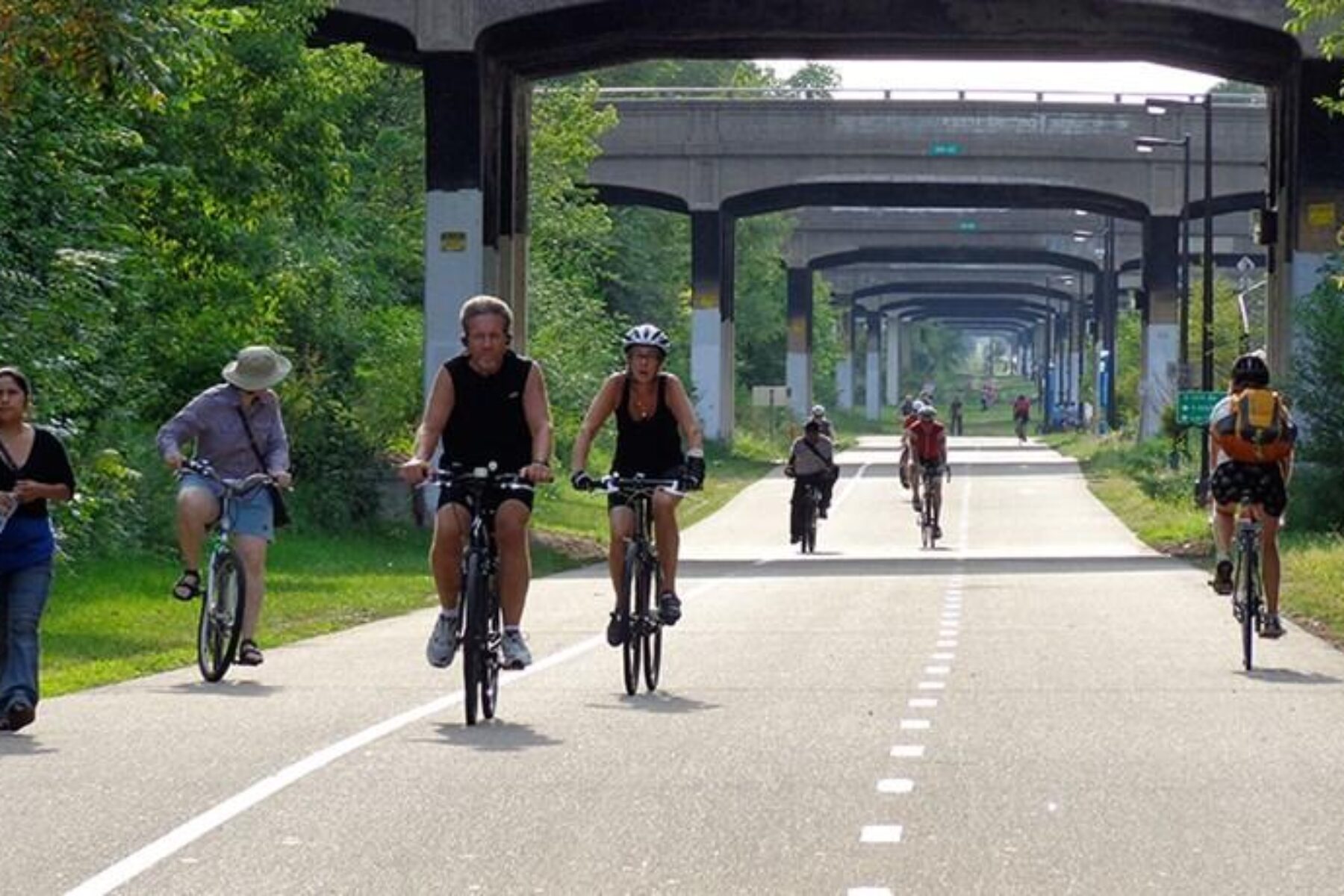
Trail of the Month: October 2015
“If you imagine a bicycling transportation utopia, we have largely achieved that along the Midtown Greenway.”
Hearing words like “trench” and “urban” to describe Minneapolis’ Midtown Greenway, one might picture drab gray, straight lines and impenetrable crowds; however, the walls to either side of the trail are sloped and filled with trees, bushes and organic vegetation built up over a century. Annual Arbor Day celebrations have added thousands of additional trees, making the paved, 5.5-mile pathway a lush green swath through the city’s southern neighborhoods, only minutes from downtown. Nestled 20 feet below street level in an early 20th-century railroad cut, the trail bypasses the street traffic crossing overhead on more than two dozen historical bridges. Combined with a smart design, which incorporates westbound and eastbound biking lanes, as well as a separate walking path, and you have a commuter’s paradise of both beauty and speed.
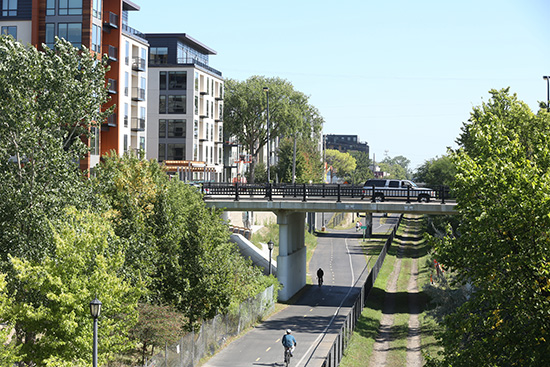
“If you imagine a bicycling transportation utopia, we have largely achieved that along the Midtown Greenway,” says Tim Springer, co-founder and first executive director of the Midtown Greenway Coalition, a nonprofit organization that advocated for the development of the trail and continues to be its voice today.
On its west end, the greenway connects to pathways looping around the city’s recreational treasures, the Chain of Lakes—described in the late 1880s as “a necklace of diamond in settings of emerald”—and, on its east end, the Mississippi River. Bounding the trail on all sides are residential neighborhoods, businesses and workplaces that “pour out onto the greenway at lunchtime,” says Soren Jensen, the coalition’s current executive director.
But the plazas that now open up onto the trail and the high-rise balconies that overlook it would once have been unthinkable.
“I will tell you they laughed at us for thinking there would be real estate investment along this trench,” says Hennepin County Commissioner Peter McLaughlin of the rail corridor that, by the early 1990s, had become little used and littered with trash. “It was a garbage dump—really unsavory.”
McLaughlin notes that the amount of real estate investment that’s sprung up around the trail in the last decade has been “unbelievable,” and property values along the corridor have gone up 90 percent or more.
McLaughlin notes that the amount of real estate investment that’s sprung up around the trail in the last decade has been “unbelievable,” and property values along the corridor have gone up 90 percent or more. Supporting neighborhood revitalization and renewal is at the core of what Hennepin County’s Midtown Community Works is all about; the public-private partnership was launched in 1994 with the Midtown Greenway as its first focal point.
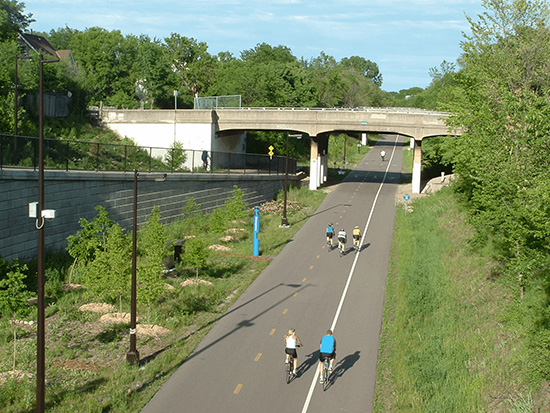
“It used to be an embarrassment,” says Jensen of the corridor. “But now it’s a gem, and people want to live there. The Midtown Greenway is part of why Minneapolis is such a great cycling city. It helped spark the city’s biking renaissance.”
Just this year, Minneapolis made its debut in the top 20 most bike-friendly cities in the world and was the only U.S. metropolis in that vaunted group. The Copenhagenize Index, which scores cities on a number of categories, including infrastructure, culture, advocacy and urban planning, was topped by well-known biking behemoths Copenhagen and Amsterdam—not bad company to keep. In 2015, the impact of the Midtown Greenway on the city and its inspiring rags-to-riches tale also made it unquestionably worthy of its entry into the Rail-Trail Hall of Fame by RTC.
Jump back in time two decades and the rail-trail was nothing more than a few well-made visuals on poster board carried around by George Puzak, who was in his early 30s back then, newly married and self-employed. With him, he also toted a carousel of slides and a stack of leaflets about how the trail could benefit the city. His father, a Navy man, had taken his family to several countries where Puzak had seen grand plazas, beautiful parks and leafy boulevards, so when he heard about the largely disused 29th Street rail corridor, he dreamed big.
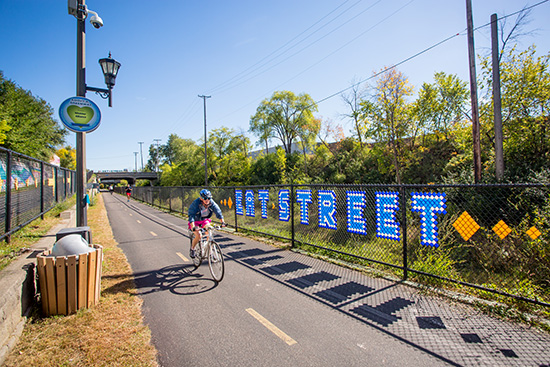
“I went to all corners of Minneapolis,” Puzak says of his presentation. “I would go to activity groups, nature groups, Rotary groups, business groups, bike conferences—wherever I could to spread the word.”
Soon he crossed paths with Tim Springer, and the two would go on to establish the Midtown Greenway Coalition in 1995. Springer recalls that when Puzak first told him about the idea, he was “sold immediately.” He adds, “I’ve always been interested in fast, pleasant and safe transportation, and the Midtown Greenway is all three on steroids.”
Of those early days when the organization was comprised of only a handful of advocates, Springer says, “We started meeting in our living rooms and backyards over lemonade and beer, and the concept grew because it was so compelling.”
This passionate local support is showcased in the coalition’s board of directors, which includes representatives from each of the 17 neighborhoods surrounding the trail. “I call it the ‘People’s Greenway,’” says Puzak. “Because a lot of people put their time, donations and sweat equity into it.”
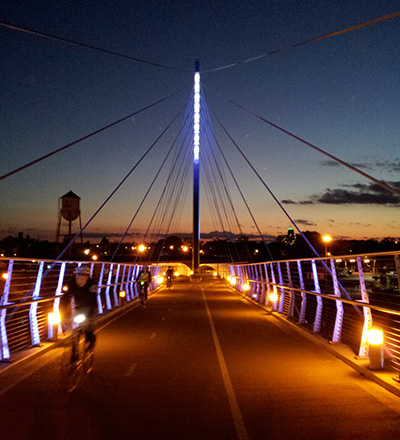
The Midtown Greenway’s first phase—on the trail’s west end—opened in 2000, and the trail progressed eastward, opening in two more phases in 2004 and 2006. Today, the trail is treated as a key piece of the city’s infrastructure.
“It’s lit at night, plowed in winter and open 24/7 like a roadway,” says Springer. “It’s operated and maintained by the public works department as a transportation facility.”
A useful addition came in 2007 with the opening of the Martin Olav Sabo Bridge, which offered pedestrians and bicyclists safe passage over busy Hiawatha Avenue, but also something more. The suspension bridge itself was eye-catching and provided elevated views of downtown Minneapolis.
“The Sabo Bridge is one of the most beautiful spots on the Midtown Greenway,” says Springer. “People gather there for sunsets. And, at night, the bridge deck hangs from cables that are lit with a bluish purple color; it looks like lasers in the sky.”
East of the bridge, the Minnesota Commercial Railway, a short line railroad, still operates freight trains on a portion of the corridor in a scenario known as rail-with-trail. A future consideration is adding passenger transit service along the trail, as well. The Hennepin County Regional Railroad Authority, which owns the right-of-way, has preserved space along the south side of the Midtown Greenway for a potential light rail line.
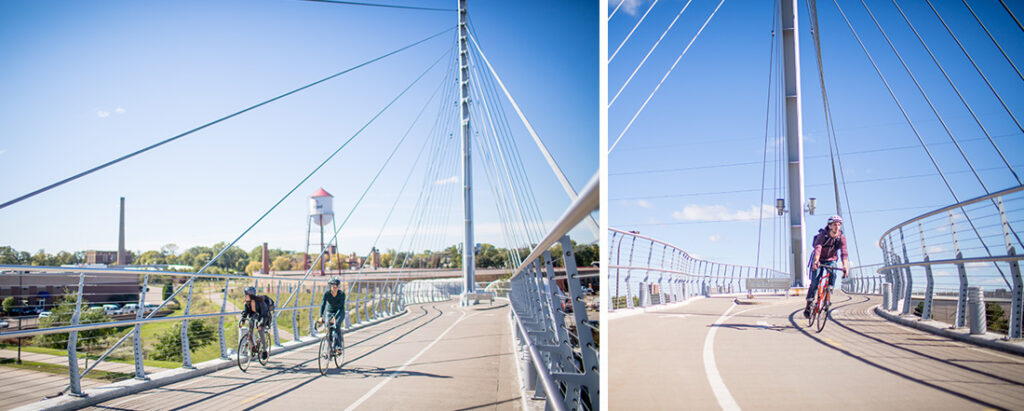
“There aren’t any amenities on that side because they’re saving it for future rail,” says Jensen, whose organization recommends a grassed track through the corridor and wire-free streetcars to minimize the impact on the greenway. “We believe that if it’s done the right way, it will be a good asset for the community.”
Already, the trail is only two blocks from a Blue Line station on the Metro light rail system, which welcomes bicyclists and opens up opportunities to connect to popular destinations like the Mall of America, the airport and Target Field, home of the Minnesota Twins baseball team. Several stations for Nice Ride—the country’s fourth-largest bike-sharing program—are also nearby, enhancing the trail’s convenience.
Another project currently in progress is improving the trail’s wayfinding signage. “Because it’s in a trench, it’s hard to know where you are,” says Jensen. “There’s a commercial corridor with businesses only a block away, but you can’t see it from the trail. There’s also the challenge of finding the ramps [down to the trail] on street level. There are no kiosks up there, no arches or entryways.”
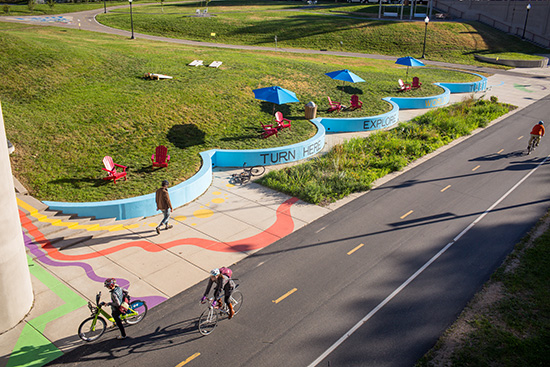
This past August and September, temporary design elements—both artistic and functional—were added to key access points along the greenway to draw attention to nearby destinations, shops and restaurants. Feedback and data on the endeavor will be collected throughout October to help develop strategies for permanent improvements.
“We’re experimenting with different wayfinding techniques to increase the connections to the surrounding neighborhoods,” says McLaughlin of the project.
While the enhancements will make the Midtown Greenway even better, the trail, which sees 1.5 million users annually, has already proven itself. Jensen, who rides the trail regularly, says, “I have one of the best commutes in the nation. It’s a wonderful way to start the day. People smile. They’re just happy to be on the greenway.”

Donate
Everyone deserves access to safe ways to walk, bike, and be active outdoors.
